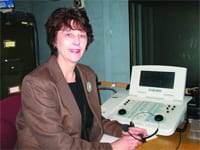Hear Today, Gone Tomorrow Senior Citizens Grapple with the Challenges of Hearing Loss
Imagine, Jeanne Coburn said, a man in his 70s, sitting with his doctor, answering routine medical questions.
“In this day of electronic medical records, the doctor is looking down at his laptop, and the patient can’t hear everything because the words aren’t traveling right toward him,” said Coburn, an audiologist with Baystate Rehabilitation Services. “To the doctor, that person might appear confused, or seem to have some dementia or cognitive decline, when in reality he can’t communicate because of hearing loss.”
That’s a scenario that gets played out every day. Research shows that, while hearing loss is common to the elderly — affecting one-quarter of those above age 65, half of those 75 and up, and 80{06cf2b9696b159f874511d23dbc893eb1ac83014175ed30550cfff22781411e5} of those 85 and up, according to the Centers for Disease Control and Prevention — it typically takes 10 to 15 years for someone to seek help for the problem, usually at the behest of a family member who’s tired of repeating everything multiple times.
Clearly, there’s a stigma about hearing loss, particularly considering that its most common remedy, the hearing aid, is so visible to others. But as new equipment allows for more effective restoration of hearing than ever before, Coburn and others say, the years of denial simply aren’t worth the impact poor hearing can have on quality of life.
“Many elderly people are depressed about a variety of issues, yet they dismiss the importance of conversation,” said Janice Walker, an audiologist and manager of the Speech and Hearing Program at Holyoke Medical Center.
People say, ‘I don’t need to hear,’ ‘I hear everything I need to hear,’ or ‘it’s OK to put this on the back burner.’ But it does affect your life.”
This month, The Healthcare News examines the causes of hearing loss in the elderly, why some older people feel anxious about admitting a problem, and how technology is working wonders for those who do get help.
Booming Problem
Out of 43 million Americans who have disabilities, said Walker, 28 million have hearing loss — that’s almost one in 10 people in the U.S.
“Hearing loss ranks up there with arthritis, high blood pressure, and heart disease as one of the most common physical problems in older people,” she noted. “It’s also hereditary; you might not always know it because it can skip a generation.”
Although hearing deterioration is a normal part of aging, other factors may come into play, Coburn said. Diabetes, heart disease, and poor circulation may all contribute to a loss of auditory faculties, while many of the medicines seniors take — thousands of them, in fact — list hearing loss as a possible side effect.
“In many, it’s not a common side effect,” she said, “but if a person is on five, six, seven medications, and three of them have a side effect of possible hearing loss or tinnitus, those medications can act synergistically and cause a greater problem than taking any one of them alone.”
Other factors in hearing loss affect the young and old equally, among them noise exposure and cancer treatments such as radiation and chemotherapy, Walker noted.
Yet, despite its prevalence, older people tend to be reluctant to get help. In some cases, the condition comes on so gradually that they don’t realize what they’re missing; Walker said people who get fitted for hearing aids often are surprised that they have to adjust to suddenly-audible background sounds like Velcro and paper crinkling. But often, seniors who want to remain active — a description that certainly fits the Baby Boom generation — perceive a stigma around hearing loss, despite its prevalence.
“Probably the number-one complaint I’ve heard from patients is that ‘my hearing aid makes me look old,’” Walker said. “I’ve had people 80 and 90 years old tell me that. Well, you are old, and you have to work with it and do the best you can.”
On the plus side, she said, hearing aids have gotten smaller — to the point, in fact, that some patients have trouble locating the batteries or cleaning it out.
One popular option, Coburn said, is what’s known as an ‘open-fit’ hearing aid, which employs a tiny, thin tube that doesn’t plug up the ear like older devices do, and is less noticeable than traditional, behind-the-ear models.
Because of its design, she said, it lets sound travel normally within the ear as well as electronically amplifying it. “And I’ve found that if Baby Boomers find something cosmetically appealing, they really embrace the technology.”
Pump Up the Volume
The stigma some associate with hearing loss can be dangerous, or at least a drain on quality of life. Although delaying being treated doesn’t worsen hearing in the long run, the years spent without a needed hearing aid can interfere with one’s understanding of a doctor’s advice, and even the ability to live independently and safely. “You’ve got to be aware of doorbells, cars approaching, furnaces going on and off — just being aware of your environment,” Walker said.
Even losing out on daily chit-chat, in part because of the frustration of family and friends, can contribute to feelings of isolation and depression, Coburn said. “People get tired of repeating themselves. If they have to tell you something three times to get their point across, they might not want to bother.”
For those willing to get help, hearing aids continue to improve in quality, she continued, citing as one example the concern users have about sound levels in a noisy environment, such as a party or a packed restaurant. But modern, digital hearing aids typically feature two different microphones: an omnidirectional one that picks up sound from all directions, and a second that picks up sound close by from the front and side, so that a conversation doesn’t get lost in surrounding din.
In addition, today’s hearing aids are also better able to monitor for ‘steady-state’ sounds, such as a running dishwasher or a car engine, Coburn explained. “When it hears a steady-state noise, it analyzes the pitch of the noise and decreases the sound of the noise, while enhancing the volume of speech.”
While the technology isn’t foolproof — a particularly loud neighboring table in a restaurant might pose a problem — it certainly makes the hearing aid ‘smarter’ than past-generation models.
Some new hearing aids even boast Bluetooth technology that interacts with wireless devices like cell phones. “Baby Boomers are loving this,” Coburn said.
Implantable hearing aids are also on the horizon, said Walker, as engineers work on ways to recharge their batteries externally, perhaps with a kind of magnet held up to the head. Cochlear implants, which bypass the damaged parts of the ear and directly stimulate the auditory nerve, are a current option for severely hearing-impaired people. But no therapy is going to totally restore hearing, she noted.
“People complain that hearing aids never make their hearing normal again,” she told The Healthcare News. “That’s true, but they do make it better. And although any new technology is expensive, costs will come down over time.”
The costs of doing nothing, on the other hand, are often significant. That’s a message, audiologists say, that seniors should be hearing loud and clear.


